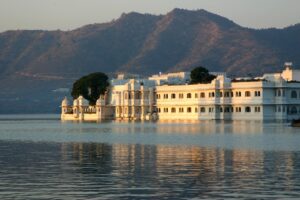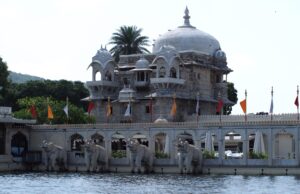Udaipur: The City of Lakes, Palaces, and Eternal Beauty
Nestled in the lush valleys of the Aravalli Hills, Udaipur is a city that exudes regal splendor and timeless beauty. Often referred to as the “Venice of the East” and the “City of Lakes,” Udaipur is one of the most picturesque cities in India. With its serene lakes, majestic palaces, ornate temples, and vibrant culture, Udaipur has long been a favorite destination for tourists, historians, and artists alike. In this blog, we’ll take an immersive journey through Udaipur, exploring its history, cultural richness, iconic landmarks, and the unique experiences it offers.
A Glimpse Into Udaipur’s History
 Udaipur’s foundation is steeped in history and heroism. Founded in 1559 by Maharana Udai Singh II, Udaipur became the new capital of the Mewar kingdom after the Mughal Emperor Akbar besieged Chittorgarh. The city was strategically built around Lake Pichola, providing it with both a defensive advantage and a stunning backdrop.
Udaipur’s foundation is steeped in history and heroism. Founded in 1559 by Maharana Udai Singh II, Udaipur became the new capital of the Mewar kingdom after the Mughal Emperor Akbar besieged Chittorgarh. The city was strategically built around Lake Pichola, providing it with both a defensive advantage and a stunning backdrop.
Maharana Udai Singh and his successors were Rajputs, known for their fierce resistance to Mughal rule. Udaipur remained a bastion of Rajput pride and culture, and it played a pivotal role in maintaining the independence of the Mewar kingdom. Even today, Udaipur is dotted with palaces, forts, and temples that echo the glory of its regal past.
The Lakes of Udaipur: A Scenic Masterpiece
Udaipur is renowned for its artificial lakes, which add to its ethereal charm and serenity. The most famous of these lakes are:
1. Lake Pichola
Lake Pichola is the most famous of Udaipur’s lakes and perhaps the most beautiful. Surrounded by rolling hills, majestic palaces, and ghats, the lake is a serene retreat. The iconic Lake Palace, which seems to float in the middle of the lake, is one of the most recognizable landmarks in Udaipur. Originally built as a royal summer palace, it has now been converted into a luxury hotel, offering an unforgettable experience to those fortunate enough to stay there.
A boat ride on Lake Pichola during sunrise or sunset is a must-do. As the golden light reflects off the surrounding buildings, the lake transforms into a magical mirror of Udaipur’s beauty.
2. Fateh Sagar Lake
North of Lake Pichola lies the expansive Fateh Sagar Lake, which is connected to Lake Pichola via a canal. It was originally built by Maharana Jai Singh but was rebuilt by Maharana Fateh Singh after a flood destroyed the dam. Fateh Sagar is famous for its three islands, one of which houses the Nehru Park, a popular picnic spot. Another island contains the Udaipur Solar Observatory, while the third is a public park. Fateh Sagar is a quieter lake compared to Pichola, but its scenic surroundings make it a favorite for those seeking tranquility.
3. Lake Badi (Jiyan Sagar)
A lesser-known gem, Lake Badi, was constructed by Maharana Raj Singh in the 17th century to alleviate water scarcity caused by a severe drought. The lake is about 10 kilometers from Udaipur and is relatively untouched by tourist crowds, offering a peaceful retreat for nature lovers. The panoramic views from **Badi Hill**, which overlooks the lake, are simply breathtaking.
Udaipur’s Palaces: Living Testimonies of Royal Grandeur
Udaipur’s royal heritage is best reflected in its stunning palaces, which combine Mughal, Rajput, and European architectural styles. These palaces are not just remnants of the past but are living testimonies of the grandeur and opulence of the Rajput rulers.
1. City Palace
The City Palace of Udaipur is the largest and most impressive structure in the city. Perched on the eastern banks of Lake Pichola, it’s a sprawling complex of several palaces built over centuries, with the main palace dating back to 1559. The architecture is a harmonious blend of Rajasthani, Mughal, and European influences, adorned with intricate carvings, inlaid marble, and delicate mirror work.
Inside, the City Palace houses museums displaying artifacts, royal attire, weapons, and miniatures, which provide insight into the life of Udaipur’s former royals. The balconies and terraces offer stunning views of Lake Pichola, the Jag Mandir Palace, and the city below.
2. Jag Mandir
Jag Mandir, often called the “Lake Garden Palace,” is another jewel of Lake Pichola. Built on an island, this palace served as a summer resort and a place of refuge. The story goes that Prince Khurram, who later became Emperor Shah Jahan, took refuge here while rebelling against his father, Emperor Jahangir. The palace is believed to have inspired him to build the Taj Mahal, evident in its Mughal-style architecture.
Jag Mandir offers an otherworldly experience with its lush gardens, marble pavilions, and imposing statues of elephants. A visit to this palace, often by boat, feels like a trip to a dreamlike world where time stands still.
3. Monsoon Palace (Sajjan Garh Palace)
Situated on a hill overlooking Udaipur, the Monsoon Palace offers panoramic views of the lakes, palaces, and the surrounding countryside. Built by Maharana Sajjan Singh in the late 19th century, it was intended as a monsoon retreat and a hunting lodge. The palace is relatively simple compared to the ornate City Palace, but the views from the top more than make up for it. Watching the sunset from the Monsoon Palace is a surreal experience, where the sky seems to merge with the lakes below.
Temples: Spiritual and Architectural Marvels
Udaipur is not just a city of palaces and lakes but also a hub of spirituality. The temples here are architectural masterpieces, each telling a story of faith and devotion.
1. Jagdish Temple
Located in the heart of the city, Jagdish Temple is one of Udaipur’s most famous and revered temples. Dedicated to Lord Vishnu, it was built by Maharana Jagat Singh I in 1651. The temple is known for its intricate carvings, towering spires, and a massive black stone idol of Lord Vishnu. The outer walls of the temple are adorned with stunning sculptures depicting scenes from Hindu mythology.
2. Eklingji Temple
About 22 kilometers from Udaipur, the Eklingji Temple is one of the most important religious sites in the region. Dedicated to Lord Shiva, the temple complex was originally built in the 8th century, although it has been rebuilt and restored several times since then. The architecture of the temple is impressive, with its towering shikharas (spires) and intricately carved marble walls. The presiding deity, Lord Shiva, is worshiped here in the form of a four-faced lingam made of black marble.
The Cultural Fabric of Udaipur
Udaipur’s culture is a rich tapestry woven from its Rajput roots, vibrant arts, and unique traditions. The city has long been a center for painting, handicrafts, music, and dance, with many of these arts still thriving today.
1. Miniature Paintings
Udaipur is famous for its Mewar School of Miniature Paintings, which are characterized by their delicate brushwork, intricate details, and vibrant colors. These paintings often depict scenes from Hindu mythology, courtly life, and the royal hunt. You can see many of these works in the City Palace Museum and buy reproductions at local art galleries.
2. Handicrafts and Textiles
Udaipur is a haven for shoppers, particularly those looking for traditional Rajasthani handicrafts and textiles. The markets are full of vibrant fabrics, intricate jewelry, and beautifully crafted items like puppets, pottery, and metalwork. Hathi Pol and Bada Bazaar are two of the most popular shopping areas for tourists seeking authentic souvenirs.
3. Folk Music and Dance
The folk music and dance of Udaipur are deeply rooted in its cultural heritage. Ghoomar and Kalbeliya are two traditional Rajasthani dance forms that are performed during festivals and special occasions. The music, often accompanied by instruments like the sarangi and dholak, adds to the vibrancy of the city’s cultural scene.
Festivals: Celebrating Life in Udaipur
Festivals in Udaipur are grand, colorful, and celebrated with immense zeal. The major festivals include Mewar Festival, which celebrates the arrival of spring, and Diwali, the festival of lights. During these festivals, the city is adorned with lights, music, and performances, showcasing the vibrancy and spirit of Udaipur’s people.
Udaipur’s Cuisine: A Feast for the Senses
Udaipur’s culinary scene is as rich as its culture. Rajasthani cuisine, with its bold flavors and royal touches, is something every visitor must experience. Some must-try dishes include:
Dal Bati Churma: A classic Rajasthani dish of baked dough balls (bati) served with lentils (dal) and sweetened cereal (churma).
Laal Maas: A spicy mutton curry cooked with fiery red chilies, a favorite among non-vegetarians.
Gatte ki Sabzi: A tangy curry made with gram flour dumplings.
Dining by the lakeside, especially at one of the many rooftop restaurants overlooking Lake Pichola, is an unforgettable experience.
Udaipur: A Destination Beyond Time
Udaipur is not just a city; it’s an experience. Every corner tells a story of valiant kings, timeless beauty, and a culture that has stood the test of time. Whether you’re wandering through its majestic palaces, floating on its serene lakes, or simply soaking in the vibrant energy of its streets, Udaipur leaves an indelible mark on the soul.
A visit to this city is like stepping into a painting where history, culture, and natural beauty blend seamlessly, offering a journey that is both enriching and unforgettable.
For more blogs click here…

